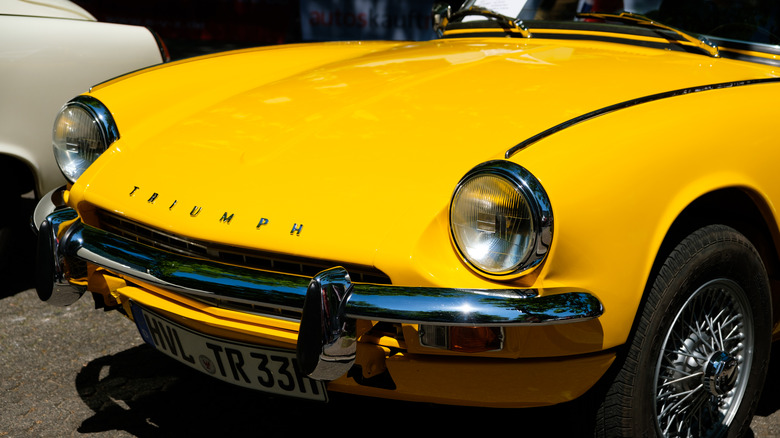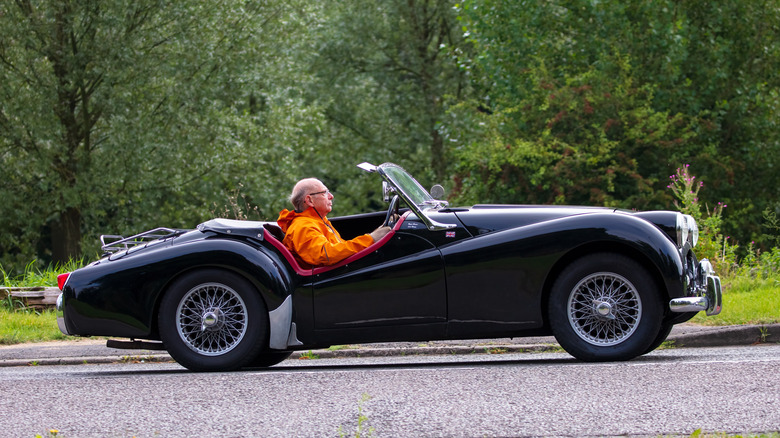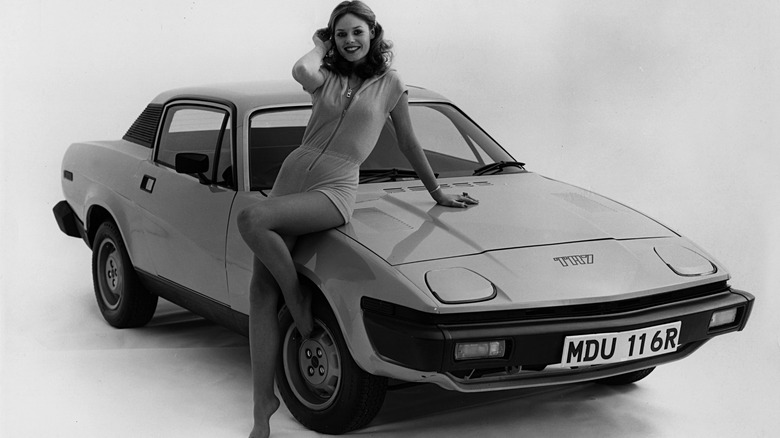
Hanohiki/Getty Images
For today’s motor enthusiasts, the Triumph name conjures up images of the thriving motorcycle brand instead of the storied line of sports cars the company once produced. In fact, at various times in its history, Triumph has manufactured both cars and motorcycles.
While Triumph is widely believed to be a wholly British endeavor, it was actually founded by a German immigrant. In 1885, Nuremberg-born Siegfried Bettmann, then living in London, started the S. Bettmann & Co. Import Export Agency, bringing bicycles to the U.K. By 1889, Triumph had changed its business model from import/export to manufacturing, opening a bicycle factory in Coventry. The first Triumph-branded bicycles hit the British market in that year. In 1902, Triumph put engines on its bikes for the first time and began to manufacture the motorcycles that would make the brand a legend. The motorbikes quickly became popular, but where do the cars come in?
Bicycles, motorcycles, and automobiles — oh my!
As the First World War loomed large in Europe, the British Army placed huge orders with Triumph for its 550cc Model H motorcycle. By the end of the war, the company had become — dare we say — England’s most triumphant motorcycle maker.
But this story isn’t about the best Triumph motorcycles ever built. The British company built by Germans wouldn’t begin making automobiles for another five years. It began in 1921, when Triumph took over the Dawson Car Company, lock, stock, and manufacturing plant. Two years later, Triumph rolled out its first car, the 10/20, deriving its name from the Royal Automobile Club’s taxation class of a 10 horsepower rating with the car’s actual output of 20 brake horsepower. The 10/20 was designed by Coventry-based engineering firm called Lea-Francis, with Triumph paying royalties on every car sold.
The steel-paneled, open tourer had two front seats with a small rumble seat at the back. It was powered by a 1.4-liter, four-cylinder engine mated to a three-speed gearbox, pushing out approximately 23 horsepower and reaching an impressive-for-the-time top speed of 52 mph.
[Featured image by FDS2 via Wikimedia Commons | Cropped and scaled | CC BY-SA 3.0]
The 1930s were not kind to Triumph
In 1930, the company changed names to embrace its automotive future, taking on the «Triumph Motor Company» name. Unfortunately, by 1936 Triumph was facing severe financial hardships, selling off both the bicycle and motorcycle businesses. In 1937, Donald Healey – technical director of Triumph from 1934 to 1939 — purchased the carmaker and created the Dolomite, a sporty straight-8 inspired by the Alfa Romeo 8C 2300.
In 1939, Triumph suffered further financial issues, falling into receivership. Steelworking company Thos. W. Ward Limited stepped in and acquired the Triumph factory, equipment, and brand. The outbreak of World War II largely halted the manufacture of civilian vehicles, but Healey stayed with Ward through the war years, building carburetors for warplanes. In 1940, the Luftwaffe bombed Triumph’s Coventry factory, putting an end to that period of Triumph auto production.
In November 1944, the Standard Motor Company purchased the remains of Triumph. A few months later, it reopened the Triumph Motor Company Limited as a subsidiary, merging with existing Standard facilities in Canley, not far from Triumph’s old home in Coventry. A new day was dawning.
[Featured image by Calreyn88 via Wikimedia Commons | Cropped and scaled | CC BY-SA 4.0]
Standard Motor builds a grudge into a dynasty

Sue Thatcher/Getty Images
The Standard Motor Company had unusual reasons for acquiring Triumph. Standard had built Jaguar engines for years, but a series of disagreements between the companies had grown so bitter that Standard managing director Sir John Black bought the Triumph brand specifically to compete with Jaguar. The first in this new line of Triumphs was the Roadster, which was made from aluminum because steel was still hard to come by after the war.
The Triumph Roadster was powered by a Standard 1.8-liter four-cylinder, side-valve engine mated to a synchromesh four-speed transmission. Ironically, it ran on the same engine Standard made for prewar Jaguars, but the Roadster had a Solex carburetor and a lower compression ratio.
New Triumph models followed. By the early 1950s, Triumph was so well-known that Standard Motor bequeathed all of its sports car manufacturing to the brand, allowing Standard to focus on sedans. Triumph unveiled the first TR badged sports car, the TR2, in 1953. The TR2 would be Triumph’s signature car until 1981.
At the end of 1960, Leyland Motors Ltd. bought the Standard-Triumph company and rolled out several new cars designed by famed Italian designer Giovanni Michelotti, including the Spitfire, which made it onto our list of greatest British sports cars of all time. In 1966, Jaguar and the British Motor Corporation merged to form British Motor Holdings,which in turn merged with Leyland Motors Ltd. to create the British Leyland Motor Corporation.
Merges and flying doorstops

Heritage Images/Getty Images
The 1960s were a tumultuous time across the U.K. auto industry. Triumph, still a British Leyland holding, became synonymous with the worst parts of British automaking across the 60s and 70s. The brand began its decline with the nominally sporty Stag which, while sleek and alluring on the surface, was so disastrously unreliable that the 1970 model appears in Time’s «50 Worst Cars of All Time.» Later designs like the Triumph TR7 and TR8 met significant hostility on release — Classic Motorsports quotes critics calling the former «a flying doorstop» and blames the latter for British carmakers ceasing to make sports cars entirely — and, despite decent sales numbers, couldn’t save the floundering British Leyland. Triumph toughed out plummeting profits, labor disputes, and an odd licensed rebadging of the Honda Ballade as a «Triumph Acclaim» before finally imploding in 1984.
The Triumph badge does still exist, however, and is once again owned by Germans. Triumph is a BMW brand now, and while the company has yet to produce a Triumph-branded car, it remains a defunct car brand we wish still existed. July 2023 even offered a glimmer of hope: To celebrate Triumph’s centennial, BMW showed an electric, single-seat concept roadster called the TR25. Where this prototype — and the Triumph name — go from here is anyone’s guess.